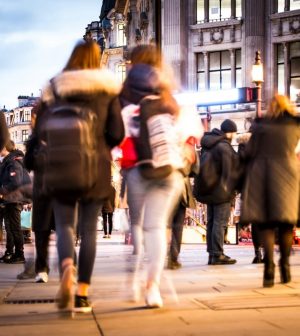- Skip Storing This Everyday Product in the Fridge Door
- Green Tea + B3 Pairing May Boost Brain Health
- Navigating Your Midlife Crisis: Embracing New Possibilities
- City Raccoons Showing Signs of Domestication
- Mapping the Exposome: Science Broadens Focus to Environmental Disease Triggers
- One Week Less on Social Media Linked to Better Mental Health
- Your Brain Changes in Stages as You Age, Study Finds
- Some Suicide Victims Show No Typical Warning Signs, Study Finds
- ByHeart Formula Faces Lawsuits After Babies Sickened With Botulism
- Switch to Vegan Diet Could Cut Your Greenhouse Gas Emissions in Half
Denser Urban Neighborhoods Get People Walking

Does a crowded neighborhood make you move more?
Yes, says new research that found people who live in highly populated areas walk more than people who live in less densely populated areas.
Since more walking is connected to better health, generally speaking, the extra steps can make a big difference in terms of promoting an active lifestyle and public health, said lead study author Glen Duncan, a Washington State University nutrition and exercise physiology professor.
“We have so many people in the U.S. population who don’t get sufficient activity. If we could shift the percentage of the population that just took on more plain old walking, we would see real health benefits,” Duncan said in a university news release.
In other words, improving local walkability, and getting more Americans to walk, can potentially boost the health of the entire population.
For this study, researchers examined twins’ activity levels by location. Neighborhoods were deemed walkable based on an index that measures the density of people, roads and desirable places to walk to — destinations such as stores, parks, restaurants and coffee shops.
The study analyzed data from surveys of 5,477 pairs of twins who lived in various parts of the United States.
Data from 2009 to 2020 — which included information about where people lived, the number of minutes they walked in a typical week and their reasons for walking — were considered.
The results revealed that those who lived in areas considered more walkable did, in fact, walk more.
The researchers found that every 1% bump in “walkability” resulted in 0.42% increase in neighborhood walking. That meant that a 55% increase in the walkability of a neighborhood prompted about 23% more walking — or about 19 minutes a week for every resident living in that area.
Making neighborhoods more walkable may also help Americans get more exercise indirectly.
What’s more, improving public transportation in suburban or rural areas that require driving to places like grocery stores or community centers would get more folks walking
Published Dec. 12 in the American Journal of Epidemiology, the new report showed a strong connection between place and activity. The more walkable neighborhoods were typically found in urban areas.
Earlier research has shown that the safety, or perceived safety, of a neighborhood influences walkability, too. Because many find safety in numbers, walking groups may help bridge the gap for would-be walkers who live in less walkable areas.
Duncan emphasized that walking is a great and easy way to improve health. It also counts toward the widely recommended 150 minutes a week of physical activity.
“You don’t have to spend loads of money on fitness clothing and the best gear. Walking is a very natural thing. You lace on some shoes and head out the door,” he noted.
More information
Find walking groups near you through the American Volkssport Association (AVA).
SOURCE: Washington State University, news release, Dec. 12, 20224
Source: HealthDay
Copyright © 2025 HealthDay. All rights reserved.










